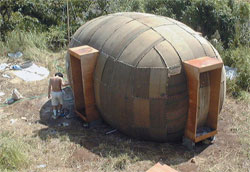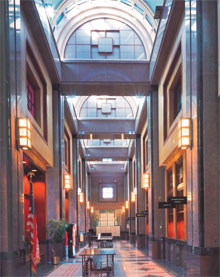




| From Hemp Houses to Embassies: Landscape and the Built Environment | |
| By Peter Rice '05 |
 |
| Hemp houses like this one are easily produced and transported, quickly assembled, and inexpensively maintained, making them ideal for temporary housing after disasters and displacements. |
| Photo courtesy of Technocraft |
Maybe refugees and other displaced people, if Cameron Sinclair gets his way. As the head of the nonprofit Architecture for Humanity, Sinclair sponsored a design contest in 2000 to find new ways of providing cheap and easy-to-assemble shelter for those displaced by war, and he’s now working on shelter for tsunami victims.
He told an audience in CC’s Packard Hall that the plan created quite a stir. “These are the craziest guys I ever met,” Sinclair said of the designers. “The only comment from the jury was: ‘If there were a fire in the village, would anyone leave?’”
Sinclair came to CC as part of the “Landscape and the Built Environment” lecture series organized by art Professor Ruth Kolarik and financed by the National Endowment for the Humanities professorship that she holds through spring 2005.
 |
| The American embassy in Santiago, Chile, was designed to rigorous new standards established after the 1983 Beirut embassy bombing. Architect Leonard Parker, limited to a 15 percent window-to-wall ratio, used rooftop skylights to bring in light. |
| Photo courtesy of Elizabeth Gill Lui. |
The point of the talks was “educating the campus community about good architecture,” says Kolarik. “The idea is to start people thinking and talking about it.”
And it worked. Matt Johnson ’05 likes to tell prospective CC students about his favorite classes, the intramural hockey program, and the landscape lecture series. “This is as unique an experience as you can get,” he says. “I thought the lecture series was great, and I’m really glad that my time at CC coincided with it.”
“I thought they were really interesting,” adds Jocelyn Oppenheim ’07. She especially enjoyed the lecture by Maya Lin, who designed the Vietnam Veterans Memorial in Washington, D.C. “I thought she was a great speaker — I like her integration of sculpture and architecture,” Oppenheim said.
The Colorado College | 14 East Cache La Poudre Street | Colo Sprgs, CO | 80903 || 719-389-6000